5.5: Han Dynasty (206 BCE – 229 CE)
- Page ID
- 219985
\( \newcommand{\vecs}[1]{\overset { \scriptstyle \rightharpoonup} {\mathbf{#1}} } \)
\( \newcommand{\vecd}[1]{\overset{-\!-\!\rightharpoonup}{\vphantom{a}\smash {#1}}} \)
\( \newcommand{\id}{\mathrm{id}}\) \( \newcommand{\Span}{\mathrm{span}}\)
( \newcommand{\kernel}{\mathrm{null}\,}\) \( \newcommand{\range}{\mathrm{range}\,}\)
\( \newcommand{\RealPart}{\mathrm{Re}}\) \( \newcommand{\ImaginaryPart}{\mathrm{Im}}\)
\( \newcommand{\Argument}{\mathrm{Arg}}\) \( \newcommand{\norm}[1]{\| #1 \|}\)
\( \newcommand{\inner}[2]{\langle #1, #2 \rangle}\)
\( \newcommand{\Span}{\mathrm{span}}\)
\( \newcommand{\id}{\mathrm{id}}\)
\( \newcommand{\Span}{\mathrm{span}}\)
\( \newcommand{\kernel}{\mathrm{null}\,}\)
\( \newcommand{\range}{\mathrm{range}\,}\)
\( \newcommand{\RealPart}{\mathrm{Re}}\)
\( \newcommand{\ImaginaryPart}{\mathrm{Im}}\)
\( \newcommand{\Argument}{\mathrm{Arg}}\)
\( \newcommand{\norm}[1]{\| #1 \|}\)
\( \newcommand{\inner}[2]{\langle #1, #2 \rangle}\)
\( \newcommand{\Span}{\mathrm{span}}\) \( \newcommand{\AA}{\unicode[.8,0]{x212B}}\)
\( \newcommand{\vectorA}[1]{\vec{#1}} % arrow\)
\( \newcommand{\vectorAt}[1]{\vec{\text{#1}}} % arrow\)
\( \newcommand{\vectorB}[1]{\overset { \scriptstyle \rightharpoonup} {\mathbf{#1}} } \)
\( \newcommand{\vectorC}[1]{\textbf{#1}} \)
\( \newcommand{\vectorD}[1]{\overrightarrow{#1}} \)
\( \newcommand{\vectorDt}[1]{\overrightarrow{\text{#1}}} \)
\( \newcommand{\vectE}[1]{\overset{-\!-\!\rightharpoonup}{\vphantom{a}\smash{\mathbf {#1}}}} \)
\( \newcommand{\vecs}[1]{\overset { \scriptstyle \rightharpoonup} {\mathbf{#1}} } \)
\( \newcommand{\vecd}[1]{\overset{-\!-\!\rightharpoonup}{\vphantom{a}\smash {#1}}} \)
\(\newcommand{\avec}{\mathbf a}\) \(\newcommand{\bvec}{\mathbf b}\) \(\newcommand{\cvec}{\mathbf c}\) \(\newcommand{\dvec}{\mathbf d}\) \(\newcommand{\dtil}{\widetilde{\mathbf d}}\) \(\newcommand{\evec}{\mathbf e}\) \(\newcommand{\fvec}{\mathbf f}\) \(\newcommand{\nvec}{\mathbf n}\) \(\newcommand{\pvec}{\mathbf p}\) \(\newcommand{\qvec}{\mathbf q}\) \(\newcommand{\svec}{\mathbf s}\) \(\newcommand{\tvec}{\mathbf t}\) \(\newcommand{\uvec}{\mathbf u}\) \(\newcommand{\vvec}{\mathbf v}\) \(\newcommand{\wvec}{\mathbf w}\) \(\newcommand{\xvec}{\mathbf x}\) \(\newcommand{\yvec}{\mathbf y}\) \(\newcommand{\zvec}{\mathbf z}\) \(\newcommand{\rvec}{\mathbf r}\) \(\newcommand{\mvec}{\mathbf m}\) \(\newcommand{\zerovec}{\mathbf 0}\) \(\newcommand{\onevec}{\mathbf 1}\) \(\newcommand{\real}{\mathbb R}\) \(\newcommand{\twovec}[2]{\left[\begin{array}{r}#1 \\ #2 \end{array}\right]}\) \(\newcommand{\ctwovec}[2]{\left[\begin{array}{c}#1 \\ #2 \end{array}\right]}\) \(\newcommand{\threevec}[3]{\left[\begin{array}{r}#1 \\ #2 \\ #3 \end{array}\right]}\) \(\newcommand{\cthreevec}[3]{\left[\begin{array}{c}#1 \\ #2 \\ #3 \end{array}\right]}\) \(\newcommand{\fourvec}[4]{\left[\begin{array}{r}#1 \\ #2 \\ #3 \\ #4 \end{array}\right]}\) \(\newcommand{\cfourvec}[4]{\left[\begin{array}{c}#1 \\ #2 \\ #3 \\ #4 \end{array}\right]}\) \(\newcommand{\fivevec}[5]{\left[\begin{array}{r}#1 \\ #2 \\ #3 \\ #4 \\ #5 \\ \end{array}\right]}\) \(\newcommand{\cfivevec}[5]{\left[\begin{array}{c}#1 \\ #2 \\ #3 \\ #4 \\ #5 \\ \end{array}\right]}\) \(\newcommand{\mattwo}[4]{\left[\begin{array}{rr}#1 \amp #2 \\ #3 \amp #4 \\ \end{array}\right]}\) \(\newcommand{\laspan}[1]{\text{Span}\{#1\}}\) \(\newcommand{\bcal}{\cal B}\) \(\newcommand{\ccal}{\cal C}\) \(\newcommand{\scal}{\cal S}\) \(\newcommand{\wcal}{\cal W}\) \(\newcommand{\ecal}{\cal E}\) \(\newcommand{\coords}[2]{\left\{#1\right\}_{#2}}\) \(\newcommand{\gray}[1]{\color{gray}{#1}}\) \(\newcommand{\lgray}[1]{\color{lightgray}{#1}}\) \(\newcommand{\rank}{\operatorname{rank}}\) \(\newcommand{\row}{\text{Row}}\) \(\newcommand{\col}{\text{Col}}\) \(\renewcommand{\row}{\text{Row}}\) \(\newcommand{\nul}{\text{Nul}}\) \(\newcommand{\var}{\text{Var}}\) \(\newcommand{\corr}{\text{corr}}\) \(\newcommand{\len}[1]{\left|#1\right|}\) \(\newcommand{\bbar}{\overline{\bvec}}\) \(\newcommand{\bhat}{\widehat{\bvec}}\) \(\newcommand{\bperp}{\bvec^\perp}\) \(\newcommand{\xhat}{\widehat{\xvec}}\) \(\newcommand{\vhat}{\widehat{\vvec}}\) \(\newcommand{\uhat}{\widehat{\uvec}}\) \(\newcommand{\what}{\widehat{\wvec}}\) \(\newcommand{\Sighat}{\widehat{\Sigma}}\) \(\newcommand{\lt}{<}\) \(\newcommand{\gt}{>}\) \(\newcommand{\amp}{&}\) \(\definecolor{fillinmathshade}{gray}{0.9}\)Introduction
As the Qin dynasty ended, many independent areas were united into one entity led by the brutal Qin emperor. After Liu Bang overturned the Qin and gained control of the country (5.5.1) as the Han emperor, he instituted new humane rules. Literature, mathematics, science, and the arts prospered throughout the country, and the period was called the golden age. The influential philosophies of Confucianism, Legalism, and Taoism thrived, and multiple ideologies grew from the basic tenets. Confucianism became the primary government orthodoxy, and to serve in the government required knowledge of Confucian texts. Daoism maintained its influence, and Buddhism started because of the expanded trade routes. The construction of schools became a priority, and many higher learning facilities expanded. The Qin dynasty had destroyed much of the Chinese literature, and during the Han dynasty, writing projects proliferated throughout the country, including works that even survive today.
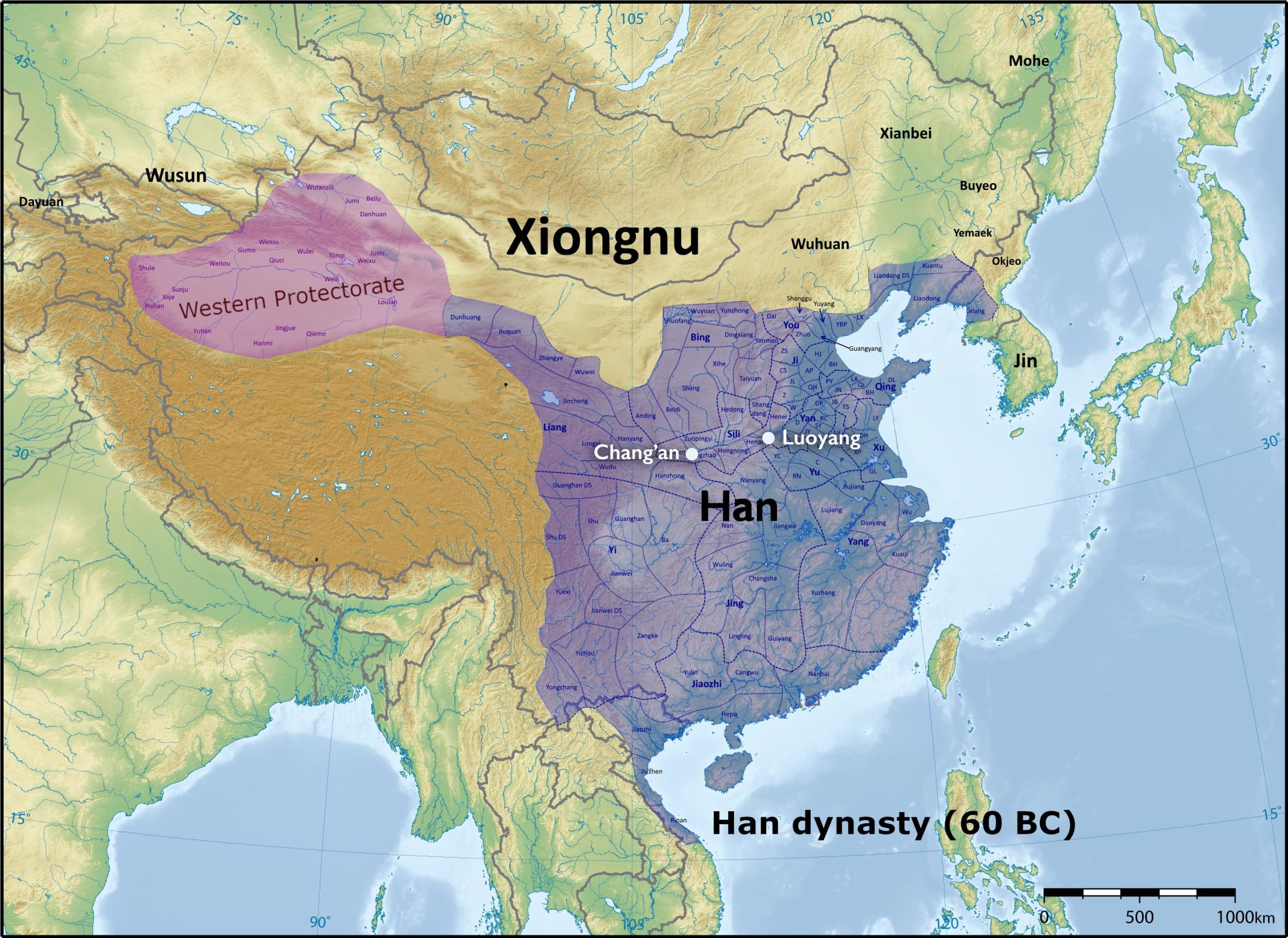
Emperor Wu, who ruled from 141-87 B.C.E., led the Han in defeating the nomadic Xiongnu and incorporated the regions of Central Asia into China. Now, the Han dynasty controlled the trading routes crossing through the central part of Asia. The routes became known as the Silk Road and stretched from the Mediterranean areas to Eastern Asia. The control of the routes brought the trade of goods, religions, and methodologies. The new routes also allowed the Mediterranean and European people access to silk.
The history of China is complex—perhaps more complex than that of other nations. The ethnic groups that compose China go back to prehistoric times, and each group lent its own color to the enormous nation. It is not like a diluted mixture of all its cultures; rather, it is a collage. Yet there are immutable elements still present today. Rice originated in China, and so did stir-frying. Anyone who has enjoyed a snack or two from a delightful swimming pool imitates the same practice in the water towns of China from times past. Brocade and printed silk fabrics were first created in China. Iridescent porcelain is a product of the Ming dynasty. The Chinese were among the first to develop blast furnaces. They were the first to invent fireworks and gunpowder. And the list goes on and on. As you read this book, you will note that history tends to repeat itself in the rise and fall of the many dynasties of China.
The Great Wall of China
During the Han dynasty, China encountered numerous conflicts with nomadic tribes that resided on the outer borders. In 138 BCE, the emperor of China dispatched an emissary to negotiate peace treaties. During his mission, the emissary had the opportunity to encounter a variety of cultures that were previously unknown to the Chinese. This exposure enabled the emissary to gain a deeper understanding and appreciation of the diverse customs and practices of these societies. The observations and insights of the emissary proved to be invaluable in shaping the Chinese perspective on the world beyond their borders. The report submitted by the emissary sparked the emperor's interest in trade, leading to the establishment of the Silk Road and subsequent development along the route.
Following the successful consolidation of various tribes' resistance, the Han dynasty opened up a new trade route in the year 110 BCE, stretching from the east of China to the west. The Han dynasty constructed fortified walls, roads, and strongholds along the route to safeguard the traders and their valuable goods from the threat of theft by nomadic groups. The Parthians, who were particularly interested in China's exquisite lacquer ware and luxurious silks, were among the primary trade partners of the Han dynasty at the outset.
“The Chinese emperor brought Parthian horses, which he admired for their speed and beauty. More and more visitors came to the Han court, where the emperor would parade them along the coast to show them the size and wealth of the Han kingdom.”[1]
In order to protect the goods and commodities being transported, people built fortifications, walls, and towers. One of the most famous examples of this was the Great Wall of Han, which was constructed by 121 BCE to defend trade routes against outside threats. The sandy desert terrain necessitated a unique style of construction to accommodate the types of raw materials available. The people used willows and reeds to weave frames and filled them with local gravel and sand. They then piled these frames in layers to create walls. The addition of water helped to consolidate the entire structure, which still stands today as a testament to the ingenuity of their builders.

1500 years before the construction of the Ming Dynasty wall was constructed, the Han Dynasty defended the borders of China from invaders with a Great Wall of their own.
Silk
"According to well-established Chinese legend, Empress Hsi Ling Shi, wife of the Emperor…was the first person to accidentally discover silk as weavable fiber. One day, when the empress was sipping tea under a mulberry tree, a cocoon fell into her cup and began to unravel. The empress became so enamored with the shimmering threads she discovered their source, the Bombyx Mori silkworm found in the white mulberry. The empress soon developed sericulture, the cultivation of silkworms, and invented the reel and loom. Thus began the history of silk. Whether or not the legend is accurate, it is certain that the earliest surviving references to silk history and production place it in China and that for nearly three millennia, the Chinese had a global monopoly on silk production."[2]
When silk was discovered in China, the methods and processes for growing silk were kept secret for centuries. People who traversed the borders were searched to safeguard against smuggling silkworms, cocoons, or eggs out of the country. The death penalty was applied to anyone caught smuggling the closely held secret of growing silk. Only those of the ruling class could legally wear silk. As the Han dynasty grew, so did the production of silk. Larger foot-powered looms increased production. Patterned and textured silk fabric (5.5.2) was easier to weave, and the large piece of silk fabric found in a tomb is covered with flowers and leaves in an elegant pattern. Previously, this type of pattern would have been complex and time-consuming to create. Silkworms needed mulberry trees to feed on, and farmers started dedicating land for tree production. Silk in China became a commodity and expanded beyond clothing to screens, fans, musical instruments, and even fishing lines. Silk developed as a valuable trade resource and export to the rest of the world. The Romans were particularly fond of silk and helped drive up the demand. The expansion of silk trading also brought safer and more reliable methods to move goods along the Silk Road.
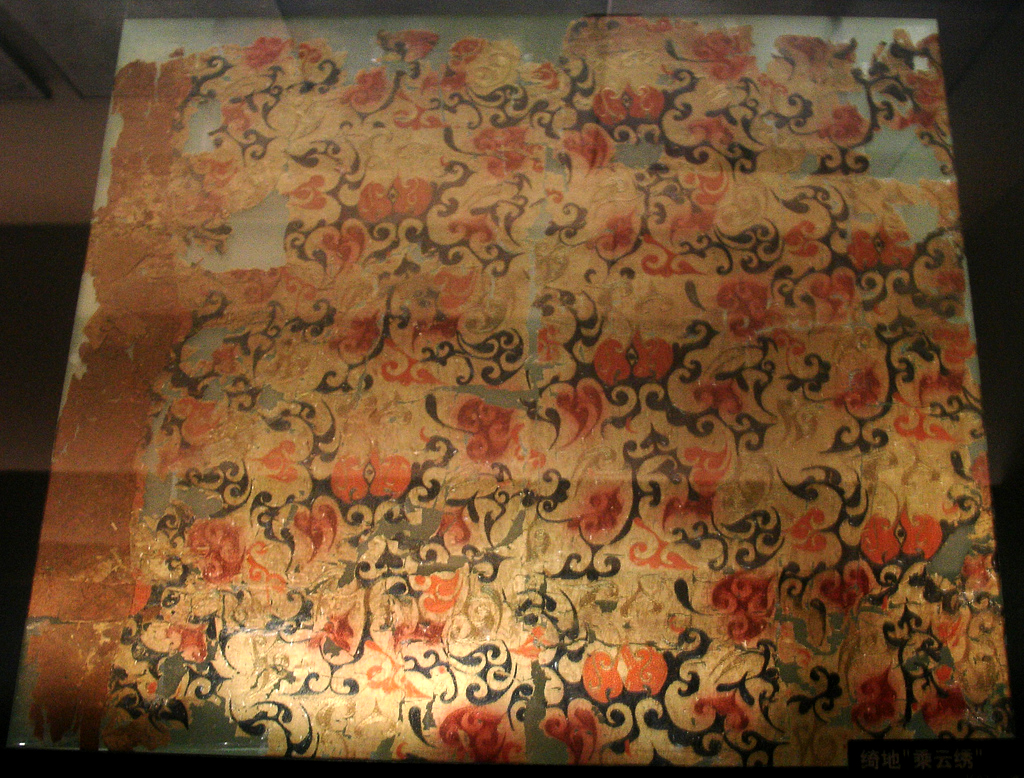
Silk, a key material in fashion and textile industries, is celebrated for its elegance and functionality. Cherished through ages in multiple cultures, this luxurious fibre, obtained from the cocoons of silkworms, has carved a niche in contemporary designs, providing a blend of tradition and innovation in fabric creation.
Burial Rituals
During the Han dynasty, the burial process expanded and was excessively elaborate, especially for the ruling class. "According to Han dynasty philosophy defining death - separation of both aspects of the soul from the body – the hun, or ethereal component leaves the corpse and ascends through heavenly realms to the kingdom of immortals, while the p'o, grounded grave-dwelling portion of the human soul, must be discouraged from abandoning the body via appeasement by tomb furnishings resplendent with all manner of material goods, earthly possessions symbolic of status and luxury, services and foods. Mingqi (glorious vessels) or objects crafted for burial with the dead, filled Han tombs, which pulse eerily in highly detailed imitation of life: replicas of green glazed earthenware farmyards, pigsties, domesticated animals, servants, musicians, and, of course, grinning chefs ready to serve."[3]
"Mingqi in the form of buildings and tools provided staples and comforts for the deceased in the tomb. Entire farms, complete with granaries, wells, and watchtowers, were recreated in miniature. Details like wooden brackets and tile roofs were loyally reproduced, as were regional differences in building styles, ranging from tall towers in the north, courtyard structures in the south, and houses perched on stilts in marshy areas. Since most of their above-ground counterparts were made of wood and have long since disintegrated, mingqi preserve information about architecture in Han China."[4]
The model of a palace (5.5.3) was made of clay with high walls. The palaces were heavily guarded, and with the walls, only a few places had gates to let others in. Anyone without specific permission to enter was excluded, and trespassers could be executed. Most of the small clay models matched actual buildings. Although actual wooden buildings have succumbed to time and weather, the small models in tombs provide a view of the architecture and use of roof tiles, walls, or balustrades. The model granary tower (5.5.4) has windows and a balcony several stories above the courtyard. Archers were located on the top floor and shot arrows out windows to entertain the ruling elite. The models found in tombs were usually copies of buildings owned or used by the deceased or some other special meaning. Having familiar buildings in the tombs allowed the dead to be surrounded by everyday objects in their afterlife.

Game boards called liubo (5.5.5) were common objects in tombs. "Both written records and archaeological finds attest to the popularity of the game of liubo (sometimes translated "six rods") during the Han dynasty. A board is divided into roads, and twelve pieces (six for each player) and dice thrown to determine moves constitute the basic equipment for the game. It is thought the pattern on the board has cosmological significance illustrative of earlier traditions of divinatory casting. These figures, (5.5.6) captured in a dramatic moment, embody the wish for the continuation of life in the tomb."[5]

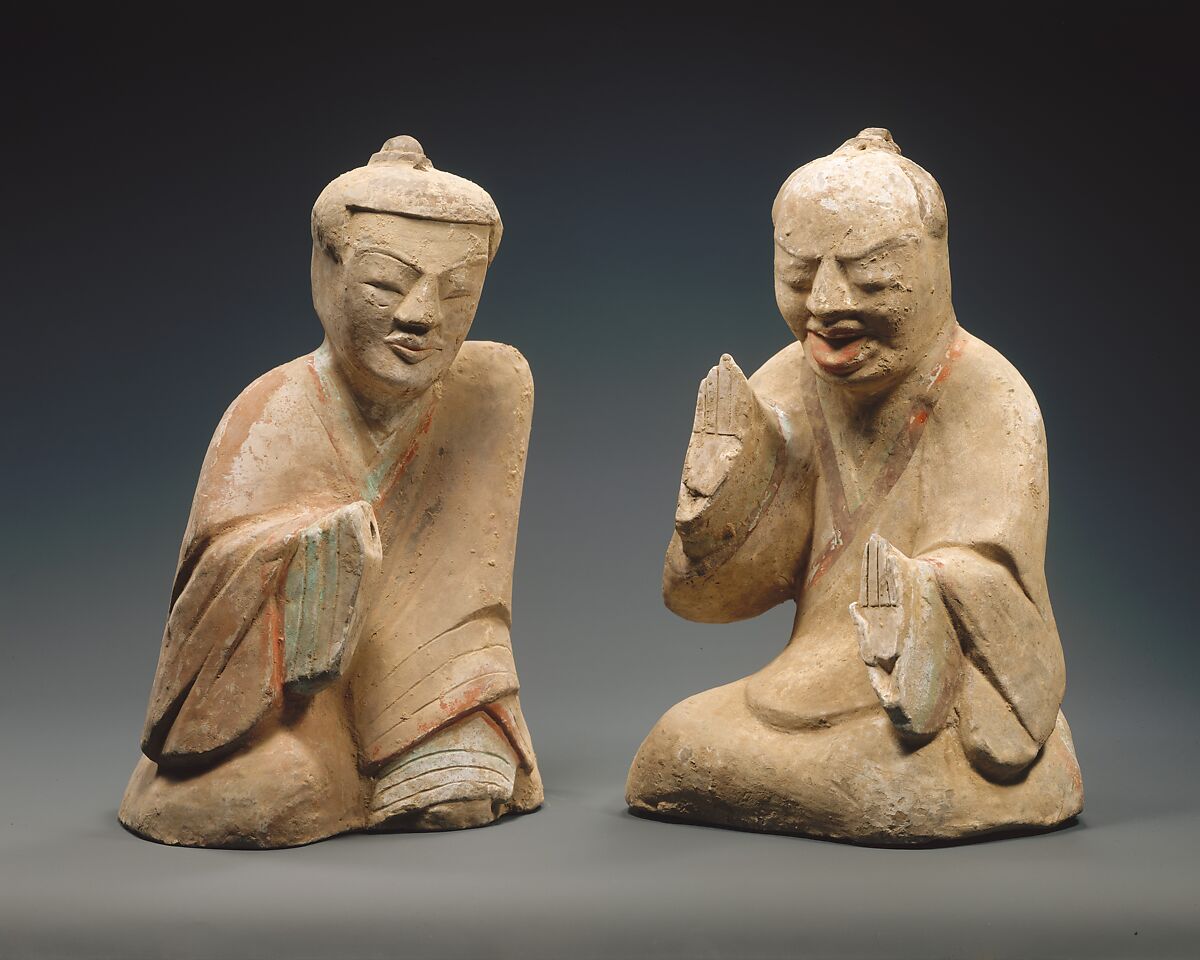
In the Han dynasty, part of the burial process was based on an obsession to preserve the body; however, it was not the same as the Egyptian mummification. Burial suits (5.5.7) made of jade were a method the Han used to preserve the body and deter bacterial decay. The jade was cut into squares, drilled with small holes, and the squares joined together with some type of thread. When the suit was on the body, the mouth, nose, and eyes (5.5.8) were enclosed with extra plugs or pieces. The thread used to join the pieces of jade was based on the person's rank: gold for very high-level rulers and the emperor, silver for those of lesser nobility, and plain copper or silk for others. Archaeologists found one body enclosed in a suit made from over 1200 tiny pieces of jade sewn with gold thread. The work to make the suits was labor intensive and usually only made for the wealthy. Once, the jade suit was a common way to wear when interred; however, grave robbers have stolen most of the suits for centuries.
One of the best-preserved bodies archaeologists found was that of Xin Zhui, known as Lady Dai. Three coffins (5.5.9) were found in tombs by each other. One was Lady Dai's coffin, one for her husband, and one for her son. The husband's tomb was in poor condition; however, Lady Dai and her son's tomb was exceptionally well preserved, with beautiful objects to see in the afterlife. Lady Dai was found inside four coffins. Each coffin was wrapped in layers of silk and nested inside each other. Layers of charcoal and white clay surrounded the coffins, helping to preserve her body.

When the body was found, it was well preserved; her skin was soft and pliable, and her muscles were flexible enough to bend her legs. Her fingerprints were still distinct. Researchers performed an autopsy on her and believe she died from a heart attack based on blood clots in her veins when she was about fifty years old. It was determined she even had type A blood. Researchers also found she probably died in the summer when melons were ripe because she had over 100 undigested melon seeds preserved in her esophagus, stomach, and intestines. She probably died shortly after eating the melon.[6]
One object archaeologists found in Lady Dai's tomb was the painted silk banner (5.5.10). The banner was found in the innermost of the four coffins and outstanding condition. Researchers do not know the exact function of the banner; however, some believe it was a name banner or, based on the images, some sort of representative of things found in Lady Dai's life. The banner was also identified as the earliest known painted portrait in China. The banner was divided into four identifiable sections. One section is a painted portrait of Lady Dai with her servants. Another section contains her funerary rituals with mourners and the offerings of food and wine.
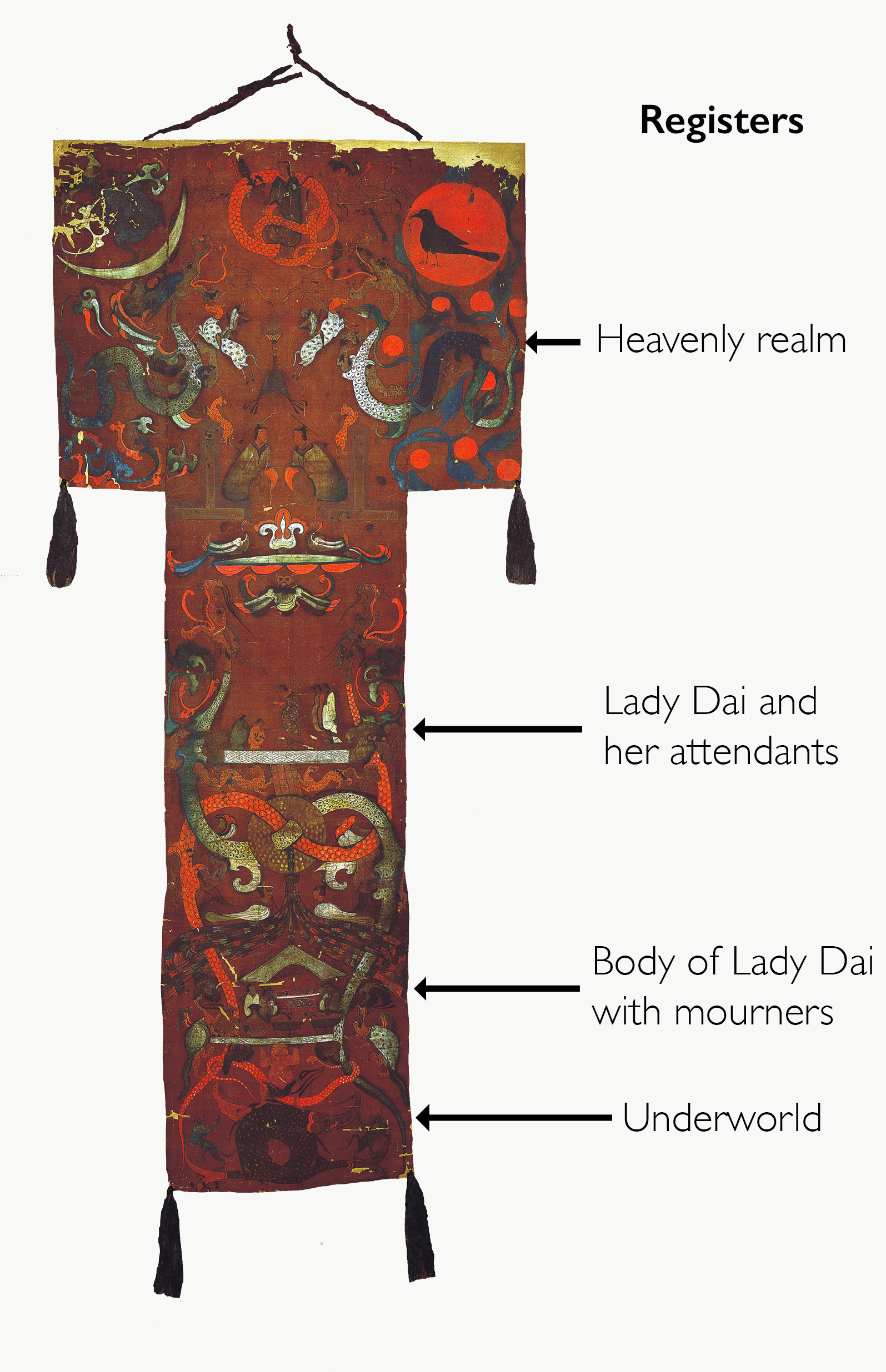 Figure \(\PageIndex{10}\): Diagram of Funeral Banner of Lady Dai (Xin Zhui) (2nd century B.C.E., silk, 205 x 92 x 47.7 cm) (Dr. Cortney E. Chaffin, "The search for immortality: The Tomb of Lady Dai," in Smarthistory, January 10, 2022, accessed December 27, 2023, https://smarthistory.org/tomb-of-lady-dai/.)
Figure \(\PageIndex{10}\): Diagram of Funeral Banner of Lady Dai (Xin Zhui) (2nd century B.C.E., silk, 205 x 92 x 47.7 cm) (Dr. Cortney E. Chaffin, "The search for immortality: The Tomb of Lady Dai," in Smarthistory, January 10, 2022, accessed December 27, 2023, https://smarthistory.org/tomb-of-lady-dai/.)The tomb contained over 1000 artifacts with containers of silk fabric, pottery, furniture, and musical instruments. Several objects were wooden replicas of Lady Dai's servants and lacquered inscribed boxes. The tomb also included copious amounts of food. "Tomb No. 1 contained forty-eight bamboo baskets of prepared meats, fruit, etc., fifty-one ceramic containers (most of them full of food), hempen sacks of cereals, vegetables, cakes of sticky rice with honey or jujube jelly, a meal served in lacquer dishes, and bamboo slips that identify and provide valuable information on the methods of preparation and composition of the dishes."[7]
Figures
In Mancheng, objects from the Changxin Palace were found in the tomb of the emperor's sisters-in-law. Originally from the palace, the figure (5.5.11) was about forty-eight centimeters high and was a "lamp, gilded with bright gold, in the form of a kneeling palace maid holding the lamp in her hands. Not only was the palace maid beautifully sculptured, but the lamp and its cover were cleverly designed so that its illuminating power and the direction of its rays were (and still are) adjustable. Since the smoke was absorbed into the maid's body through her arms, it was, in fact, an antipollution design."[8] Over 3,000 gold, silver, silk, and pottery artifacts were in the tomb.
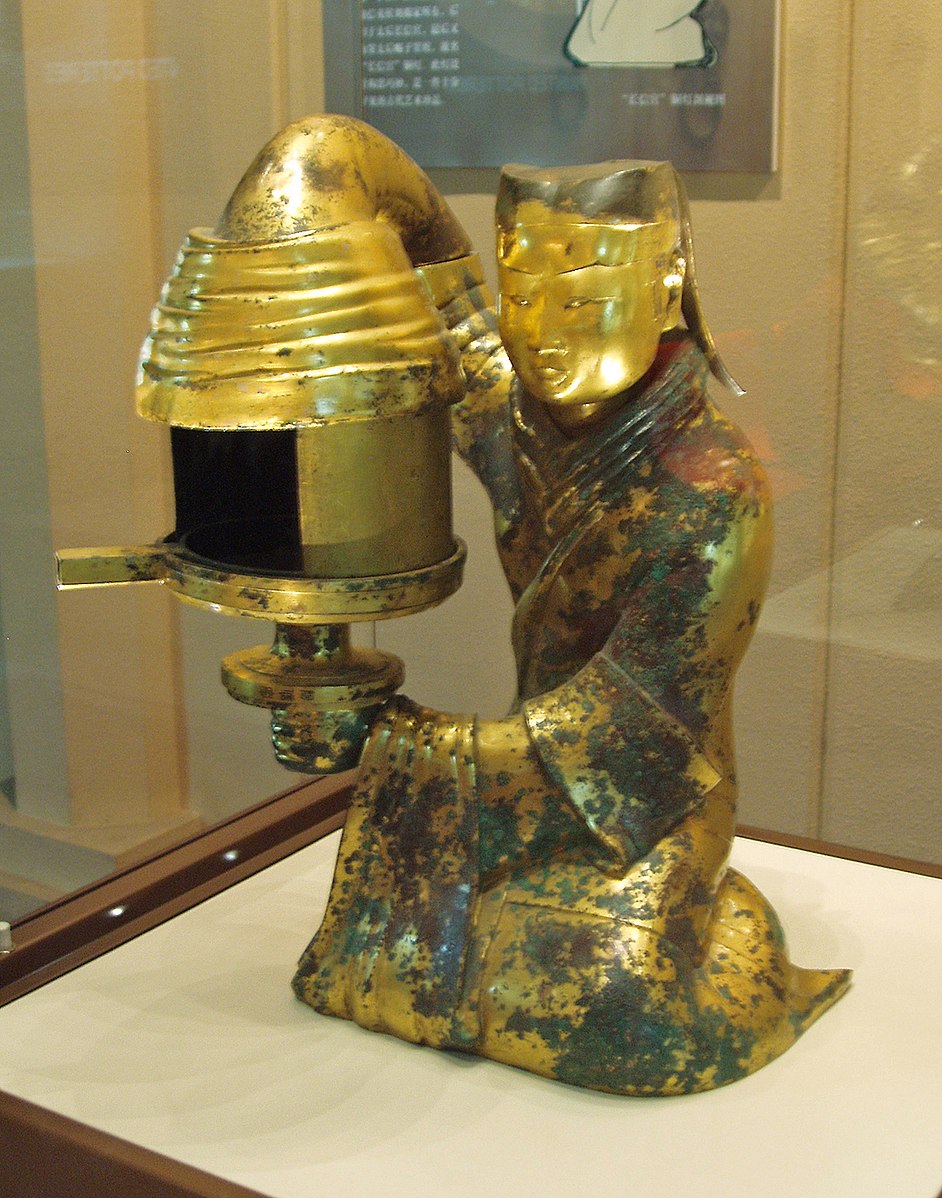
An image of a cavalryman (5.5.12) was found in a general's tomb. The rider is mounted on the horse wearing a short robe and hemp shoes, and his hair is shaped in a traditional headdress. The statue was painted at one time, and only traces of color remain today. The general would also have other clay figures representing his troops placed in his tomb. The young girl (5.5.13) is seated and dressed in silk clothing. She is holding a bronze mirror, and as she smiles, she seems happy with the image she sees in the mirror. The Han family was patrilineal, and family members maintained different statuses based on Confucian principles. Marriage rituals were essential to maintain a woman's status and not be considered a concubine. Monogamy was standard practice, as men were allowed to have concubines. Divorce and remarriage were possible. As a widow, a woman could remarry after paying the family a fee. Her children could not go with her. The figurine of a dog (5.5.14) was wearing a collar, indicating its position as a pet. Dog figurines were standard in Han tombs, taking their pets into the afterlife. Even the emperor is recorded as having dogs. This dog still has color remaining on the figure. Most figures were painted, the color worn off.


Literature, Mathematics, and Science
The original Han dynasty accommodated all the philosophies until Emperor Wu abolished all philosophies except the Confucian Five Classics. He even established the Imperial University in 124 BCE to support the ideas. The Imperial University had over 30,000 students by the 2nd century C.E.[9]
Sima Qian was China's first historian for the court and the Grand Astrologer. He recorded cultural achievements and activities, both famous and ordinary. Information was recorded in the Shiji (Historical Records or Records of the Grand Historian) (5.5.15). The writings of the manuscript covered 130 chapters of history over 3,000 years and used over 500,000 characters. "Sima Qian was an innovator in organizing and presenting the records in five sections: chronicles or annals of the emperors, chronological tables of genealogies, treatises on topics such as astronomy and the economy, hereditary families, and biographies."[10]
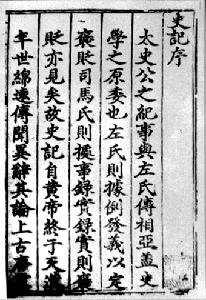
Archaeologists found the Mawangdui Silk Texts at the tombs of Mawangdui (5.5.16). The texts were paintings and manuscripts created on silk. Different recordings were also seen on bamboo slips. "Unearthed from Tomb No. 3, there were around 40 manuscripts on silk, written in about 100,000 words. Most of the manuscripts are valuable documents lost for a long time. The contents cover various subjects in politics, economics, philosophy, history, astronomy, geography, medical science, military affairs, physical training, literature, art, and so on. In addition, 11 pieces of paintings on silk, 722 slips of the "Inventory of Burial Objects" and 200 slips with inscriptions of medical treatises were unearthed from Tombs No.1 and No.3. The contents of these silk pieces and slips reveal many scientific and technological achievements and provide rare and significant materials for the study of ancient science, culture and medicine, as well as the art of painting."[11]
The Divination by Astrological and Meteorological Phenomena or the Book of Silk (5.5.17) is considered by historians to be the first definitive book about comets. Made by the astronomers of the Han dynasty, they wrote about the comets they saw over China. The astronomers illustrate every circumstance or event as the astrological phenomena were viewed. There are over twenty-nine comets, and their translation for comet was 'broom stars.' The caption under each comet in the book described an unusual event: a coming plague, a five-year drought, or other problems.
[1] Silk Road Dialogue, Diversity & Development, United Nations Educational, Scientific and Cultural Organization.
[3] The Last Feast of Lady Dai. Rauer, J., (November 2, 2006).
[4] Colburn Clydesdale, H. (2000). The Vibrant Role of Mingqi in Early Chinese Burials, Heilbrunn Timeline of Art History. New York: The Metropolitan Museum of Art.
[5] Pair of Seated Figures Playing Liubo.
[6] 2,000-Year-Old Mummy Found In Remarkable Condition With Internal Organs Intact
[7] The Last Feast of Lady Dai. Rauer, J., (November 2, 2006).
[8] Wang Z., (1982). Han Civilization, Yale University Press, p. 100.
[9] - - - (1999). The Cambridge Illustrated History of China, Cambridge: Cambridge University Press.
[10] Boyd, K., (1999). Encyclopedia of Historians and Historical Writing, Volume 1, Taylor and Francis, 1999, p. 1094


